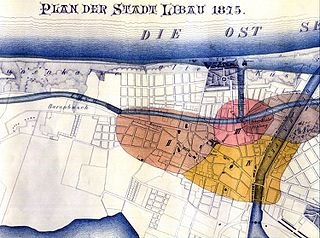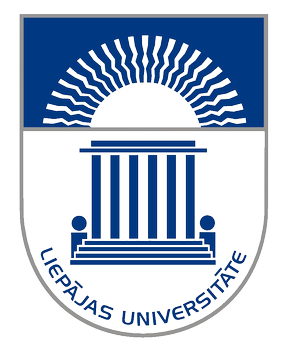
Liepāja is a state city in western Latvia, located on the Baltic Sea. It is the largest city in the Kurzeme Region and the third-largest in the country after Riga and Daugavpils. It is an important ice-free port.

Courland is one of the Historical Latvian Lands in western Latvia. Courland's largest city is Liepāja, which is the third largest city in Latvia. The regions of Semigallia and Selonia are sometimes considered as part of Courland as they were formerly held by the same duke.

Kuldīga is a town in the Courland region of Latvia, in the western part of the country. It is the center of Kuldīga Municipality with a population of approximately 13,500.

Kuldīga District was an administrative division of Latvia, located in Courland region, in the country's west. It was organized into a city and thirteen parishes, each with a local government authority. The main city in the district was Kuldīga.

Bandava - and old Curonian land which existed in the territory of the Latvia during the late Iron Age until it was conquered and divided in 1253 by Bishopric of Courland and Livonian Order.
Monument to the sailors and fishermen lost at sea is a notable modern monument and a sightseeing place in Liepāja, Latvia.
Velnciems is one of the oldest districts of Liepāja, Latvia. Located near Lauma's district, at the east side of the city.
Pērkone is a small suburban settlement in Nīca Parish, South Kurzeme Municipality, in the Courland region of Latvia. It is situated near the southern border of Liepāja. Near Pērkone is located Reiņu forest, the one of the closest to Liepāja forests.

Grīnvalti is a village in the Nīca parish of Liepāja District, Latvia. Grīnvalti is located on the narrow strip of the land between the Baltic Sea and Liepāja lake, near the southern border of Liepāja. Through it passes bus route Nr. 2092. Grīnvalti mostly known because near it in the times of Latvian SSR was located 27th border guard battery. As of 2007 in Grīnvalti is planned to build the modern residential settlement.
Wolfgang Kügler was an SS-Untersturmführer and a Teilkommandoführer for Einsatzkommando 2, a subdivision of Einsatzgruppe A. Following World War II, he was tried and found guilty of war crimes before a court in West Germany. His sentence was reported to have been 8 months in prison and a fine. The most serious charge against him was that he had organized and been a commander at the massacre of about 2,700 Jews, mostly women and children, on the beach at Liepāja, Latvia. Kügler claimed he was absent on leave in Germany when these murders occurred. After being re-arrested in 1959, Kügler killed himself in prison.

The Liepāja massacres were a series of mass executions, many public or semi-public, in and near the city of Liepāja, on the west coast of Latvia in 1941 after the German occupation of Latvia. The main perpetrators were detachments of the Einsatzgruppen, the Sicherheitsdienst (SD), the Ordnungspolizei (ORPO), and Latvian auxiliary police and militia forces. Heer soldiers and German naval personnel were present during shootings. In addition to Jewish men, women and children, the Germans and their Latvian collaborators also killed Roma (c.100), communists, the mentally ill and so-called "hostages". In contrast to most other Holocaust murders in Latvia, the killings at Liepāja were done in open places. About 5,000 of the 5,700 Jews trapped in Liepāja were shot, most of them in 1941. The killings occurred at a variety of places within and outside of the city, including Rainis Park in the city center, and areas near the harbor, the Olympic Stadium, and the lighthouse. The largest massacre, of 2,731 Jews and 23 communists, occurred in the dunes surrounding the town of Šķēde, north of the city center. This massacre, which was perpetrated on a disused Latvian Army training ground, was conducted by German and collaborator forces from December 15 to 17, 1941. More is known about the killing of the Jews of Liepāja than in any other city in Latvia except for Riga.

Līva was a famous river in Kurzeme in today's Latvia. It was located between the Baltic Sea and Liepāja Lake and had a length of about 6 kilometres and a width near the mouth of about 50 metres. The source of the Līva was located in Liepāja Lake near the former Pērkone river. The place where the Līva fell into the Baltic Sea was located approximately at the site of today's northern harbour in Liepāja. The river had one known island, Perkunen ; it was located near the source of the river. The Līva served as a water trade way to Grobiņa via the Liepāja lake and the port was located on it. The original suburb with a name Līva was located about 1 kilometre from the mouth of the river on both sides of it. The old name for the city Liepāja descends from the name of the river and for the centuries was associated with it. The part of the river near the mouth had become too shallow by the end of the 15th century. In the 16th century, the first Līva channel was dug up between Līva and Baltic Sea with a length of about 780 metres and a width of 50 metres. In 1697–1703, the new Trade channel was dug up and few years later the river was filled up.

University of Liepāja is a university in Liepāja, Latvia. The University of Liepāja attained university status on June 12, 2008, following the adoption of the law "On the Constitution of the University of Liepāja" by the Saeima. It holds the distinction of being the newest university in Latvia and the sole university in Kurzeme region. Prior to its university designation, it operated under the name Liepaja Pedagogical Academy, having been known as Liepaja Pedagogical Institute from its founding in 1954 until 1993
Dienvidrietumu rajons or Southwestern region is one of the neighbourhoods of Liepāja, Latvia.
Aucugals is one of the suburbs of Liepāja, Latvia.
Jaunliepāja is one of the neighbourhoods of Liepāja, Latvia.
Zaļā birze is one of the modern neighbourhoods of Liepāja, Latvia and is located in the north-eastern part of the city. The Zaļā birze neighborhood hosts the Liepāja Central Hospital and the Liepāja Business Center.

Kapsēde is one of the suburbs of Liepāja, Latvia.

The Tebra is a river in the South Kurzeme Municipality of Courland, Latvia. Its source is Podnieki Lake in the Kalvene Parish of western Latvia. Several large populated areas are located on the banks of the Tebra river, including Aizpute, Štakeldanga, and Apriki. The river is crossed by the P112 motorway.

South Kurzeme Municipality is one of the 35 municipalities established in Latvia in 2021. It surrounds Liepāja, Latvia's third largest city. Its first elected municipal council took office on 1 July 2021. Its seat is at Grobiņa.













